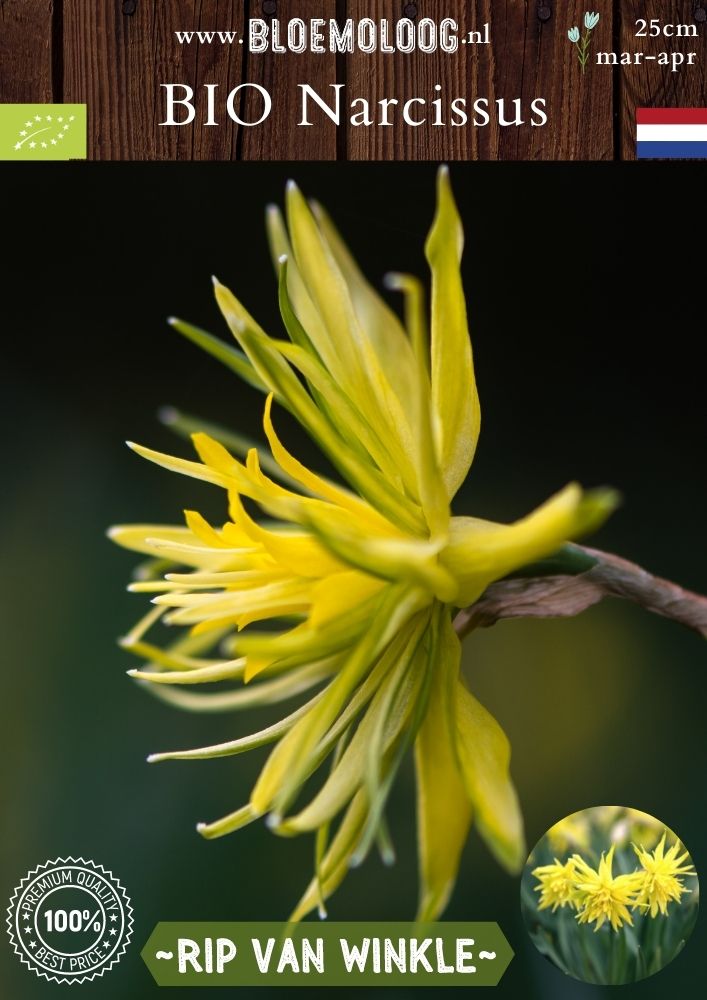Bloemoloog
Estimated Shipping Widget will be displayed here!
Couldn't load pickup availability
Organic yellow double flowered daffodil
Daffodil 'Rip van Winkle' is a striking and unique cultivar within the genus Narcissus. This Irish dwarf daffodil is known for its characteristic flower shape and vibrant color. The flowers of 'Rip van Winkle' are double, with numerous wavy, narrow petals that create a layered effect. The petals have a bright, sunny yellow color that immediately catches the eye. The flowers have a playful and fairytale appearance, making them a great addition to borders, rock gardens, containers or flower beds.
The dwarf growth of this daffodil also makes it possible to use them in smaller gardens or as part of flower arrangements. It grows to about 25 centimeters high with one or more bluish-green flower stems per bulb and narrow long leaves with the flowers still sticking out above and has one flower per flower stem. She is an early flowering Daffodil that blooms for about 4 weeks in the period March and April. All in all, the Narcissus 'Rip van Winkle' is a captivating and enchanting variety that is guaranteed to turn heads.
She is very suitable as a cut flower, she smells wonderful.
Combine it with Muscari 'Armeniacum' or Tulipa 'Little Beauty'.
How, where and when do I plant a daffodil bulb?
An organic daffodil flowerbulb needs a cold period, so plant it in the ground from September to January. The planting depth is 2 to 3 times the height of the flowerbulb itself and the planting distance is 2 to 3 times the width of the flowerbulb itself. When planting in pots, the flowerbulbs may be planted closer together and may extend half above the ground for a decorative effect. However, after flowering, the flowerbulbs should be planted back in the garden, while maintaining the planting depth and spacing discussed.
Plant the 'Rip van Winkle' in a sunny to semi-shaded spot in the garden, pot or lawn. Plant it in groups in a nutrient-rich, water-permeable, preferably calcareous, sandy soil, but it will also grow in clay soil. As long as the soil is well-drained and does not retain excess water. If you have clay soil, you can improve the soil by adding organic matter such as compost or well-rotted manure to improve drainage.
Daffodil bulbs are poisonous, which is why they are avoided by rodents such as voles. Use them as a natural protection for other flowerbulbs by planting them around and between the other bulbs.
Care of the daffodil
Provide organic nutrition during planting. Cut off the spent flowers at the top and let the rest of the foliage die. Only cut it off when the leaf has completely dried out. The daffodil 'Rip van Winkle' is a strong species that naturalizes well. She comes back every year faithfully. Provide organic food annually for optimal results.
Propagation
For propagation, the flowerbulb can be dug out at the beginning of summer. The flowerbulb is dried and stored in a warm place. They can be planted again from September. Plant the small bulbs separately and provide organic nutrition so that the small flowerbulbs grow quickly.
Origin of the daffodil
The daffodil is an ancient genus dating back to the late Oligocene and early Miocene epochs. Originally from southwestern Europe, they are now found in many parts of the world. The *Narcissus* 'Rip van Winkle' is a historic, heirloom daffodil first recorded around 1884. The name "Rip van Winkle" is possibly a nod to the story by Washington Irving, in which the main character awakens from a long sleep to find a changed world. Much like how this daffodil reawakens from its "winter sleep" every spring.
Buy Organic Narcissus 'Rip van Winkle'
Skal NL-BIO-01 certified: 109459
Packed per 10 flower bulbs or choose a stacking discount!
Stacking discount: E
Can be ordered from June '25!
EU shipping €8.95 - Free shipping from €100 purchase.
Characteristics
| Flowering time: | March - April |
| Planting time: |
From September |
| Planting depth: |
15 cm deep |
| Planting distance: | 10 cm apart |
| Height: |
25 cm high |
| Flower diameter: |
10 cm wide |
| Location: |
Partial shade, sun |
| Soil PH: | Clay, loam, sandy soil - Slightly acidic/neutral |
| Winter hardiness: |
Good hardy |
| Propagation: | Good (naturalizes) |
| Family: |
Amaryllidaceae (daffodil family) |
| Group: | Double flowered |
| Colour: |
Yellow |
| Bee-friendly: | No |
| Fragrant: | No |
| Bulb size: | 12/14 |
Other daffodil varieties

NL-BIO-01
To share




